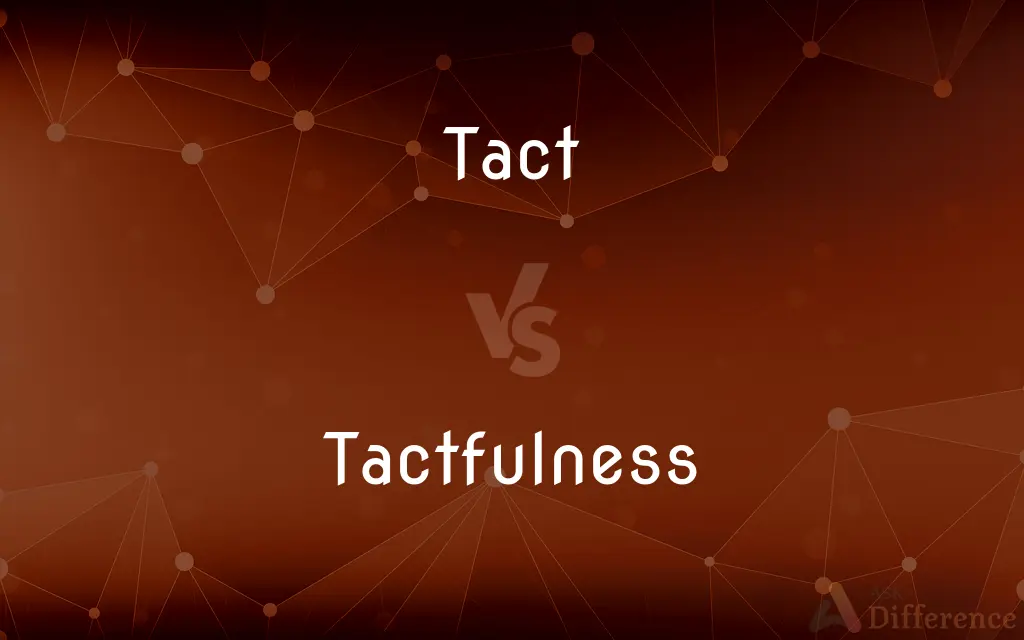Tact vs. Tactfulness — What's the Difference?
Edited by Tayyaba Rehman — By Urooj Arif — Updated on April 27, 2024
Tact refers to the sensitivity in dealing with others, while tactfulness is the practice of being tactful, often involving careful handling of delicate situations.

Difference Between Tact and Tactfulness
Table of Contents
ADVERTISEMENT
Key Differences
Tact is an innate or developed skill that involves sensitivity and diplomacy in interpersonal interactions, allowing one to avoid causing offense. Tactfulness, on the other hand, refers to the consistent application of tact in various situations, emphasizing the method and approach taken to maintain harmony.
Tact is crucial in delicate situations where feelings could be easily hurt, as it involves choosing the right words at the right time. Tactfulness extends this concept by not only choosing the right words but also considering the timing and context to ensure the communication is well-received.
While tact may be seen as a momentary exercise applied in specific situations, tactfulness is a habitual behavior that characterizes a person’s overall communicative style. Tactfulness involves a sustained commitment to thoughtful communication.
Tact can be developed through experiences and awareness of others' feelings and reactions. Tactfulness, however, requires consistent practice and a conscious effort to integrate tact into all aspects of communication.
In leadership and management, tact is often necessary for resolving conflicts or delivering difficult feedback. Tactfulness in these roles enhances a leader’s ability to manage people effectively, ensuring that they not only address issues but also foster a positive workplace environment.
ADVERTISEMENT
Comparison Chart
Definition
Sensitivity in dealing with others or difficult issues.
The practice of being tactful, often with consistent care and attention to detail.
Application
Specific situations requiring careful handling.
Consistent behavior across various communication scenarios.
Focus
Immediate sensitivity to feelings and reactions.
Long-term, habitual approach to sensitive communication.
Development
Can be innate or learned through social interactions.
Requires ongoing effort and practice in communication skills.
Role in Leadership
Useful in specific interactions or crises.
Integral to overall leadership style and team management.
Compare with Definitions
Tact
Discretion in dealing with others.
She used tact to discuss the sensitive issue without upsetting anyone.
Tactfulness
Habitual diplomatic behavior.
Her tactfulness in meetings always prevents conflicts.
Tact
Sensitivity in social interactions.
He showed great tact by diplomatically handling the client's complaint.
Tactfulness
Consistent sensitivity to context.
His tactfulness is shown by his thoughtful approach to team discussions.
Tact
Skill in not offending others.
Her tact in navigating the conversation avoided a potential argument.
Tactfulness
Practice of thoughtful interaction.
His tactfulness in handling feedback makes him a respected supervisor.
Tact
Diplomacy in communication.
His tact was evident when he mediated the dispute without bias.
Tactfulness
Continuous careful communication.
She maintains tactfulness in her emails, ensuring messages are well received.
Tact
Consideration of others' feelings.
He exercised tact by not bringing up the topic in such a setting.
Tactfulness
Regular consideration of emotional landscapes.
Her tactfulness in social settings makes her a beloved friend.
Tact
Acute sensitivity to what is proper and appropriate in dealing with others, including the ability to speak or act without offending.
Tactfulness
Possessing or exhibiting tact; considerate and discreet
A tactful person.
A tactful remark.
Tact
The sense of touch; feeling.
Tactfulness
The state or quality of being tactful.
His tactfulness allowed him to be honest without making enemies.
Tact
(music) The stroke in beating time.
Tactfulness
Consideration in dealing with others and avoiding giving offence
Tact
Sensitive mental touch; special skill or faculty; keen perception or discernment; ready power of appreciating and doing what is required by circumstances; the ability to say the right thing.
By the use of tact, she was able to calm her jealous husband.
I used tact when I told my fat uncle that his extra weight made him look better.
Tact
(slang) tactic
Tact
(psychology) A verbal operant which is controlled by a nonverbal stimulus (such as an object, event, or property of an object) and is maintained by nonspecific social reinforcement (praise).
Tact
Propriety; manners (etiquette).
Tact
(psychology) To use a tact (a kind of verbal operant; see noun sense).
Tact
The sense of touch; feeling.
Did you suppose that I could not make myself sensible to tact as well as sight?
Now, sight is a very refined tact.
Tact
The stroke in beating time.
Tact
Consideration in dealing with others and avoiding giving offence
Common Curiosities
Can you be tactful without being tact?
Being tactful inherently includes being tact; however, tact does not automatically imply tactfulness.
What are the benefits of tactfulness in leadership?
Tactfulness in leadership helps maintain a positive environment, encourages open communication, and effectively manages team dynamics.
How does one develop tactfulness?
Developing tactfulness involves practicing tact consistently, being aware of and sensitive to the nuances of communication.
What is the key difference between tact and tactfulness?
Tact refers to the sensitivity used in specific interactions, while tactfulness is the consistent application of tact across all communications.
Why is tact important in professional settings?
Tact is important in professional settings to manage interpersonal relationships carefully and avoid conflicts.
Is tact a skill or a trait?
Tact can be both a skill and a trait; it is a skill that can be developed and a trait that some may naturally possess.
How does tactfulness affect teamwork?
Tactfulness promotes a respectful and considerate team culture, fostering better collaboration and understanding among team members.
What are the consequences of lacking tact?
Lacking tact can lead to misunderstandings, hurt feelings, and potentially damaging personal and professional relationships.
Can tactfulness be taught?
Yes, tactfulness can be taught through training in effective communication, empathy, and conflict resolution.
How do tact and tactfulness impact conflict resolution?
Both tact and tactfulness play crucial roles in conflict resolution by ensuring that communication is sensitive and thoughtful, thereby defusing potential conflicts.
Share Your Discovery

Previous Comparison
Achievable vs. Attainable
Next Comparison
Cumin vs. JeeraAuthor Spotlight
Written by
Urooj ArifUrooj is a skilled content writer at Ask Difference, known for her exceptional ability to simplify complex topics into engaging and informative content. With a passion for research and a flair for clear, concise writing, she consistently delivers articles that resonate with our diverse audience.
Edited by
Tayyaba RehmanTayyaba Rehman is a distinguished writer, currently serving as a primary contributor to askdifference.com. As a researcher in semantics and etymology, Tayyaba's passion for the complexity of languages and their distinctions has found a perfect home on the platform. Tayyaba delves into the intricacies of language, distinguishing between commonly confused words and phrases, thereby providing clarity for readers worldwide.














































